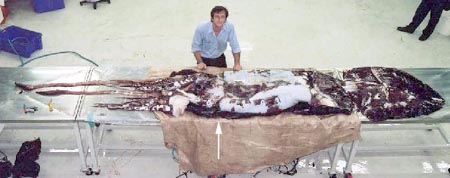Mesonychoteuthis
Mesonychoteuthis hamiltoni
Richard E. Young and Katharina M. Mangold (1922-2003)Introduction
Mesonychoteuthis hamiltoni is the largest of all cranchiid species with adults reaching over 2 m in mantle length (Nesis, 1982). It is a circumpolar Antarctic species with young found north to the subtropical convergence (Nesis, 1982).
Diagnosis
A taoniin ...
- with hooks on the arms and tentacle clubs.
Characteristics
- Arms
- Hooks present on arms.
 image info
image info Figure. Oral view of half of the arm crown (arms I-IV, arm I at top) of a juvenile M. hamiltoni, 86 mm ML. Drawing from Voss (1980), p. 395.
- Hooks present on arms.
- Tentacles
- Tentacular club with hooks.
- Diagonally set pairs of suckers and pads on distal 2/3 of tentacular stalk.
- Funnel
- Funnel valve absent.
- Funnel organ: Dorsal pad with three papillae.
- Mantle
- Tubercles absent in adults, present in paralarvae and juveniles.
- Tubercles absent in adults, present in paralarvae and juveniles.
- Fins
- Fins ovate, without anterior lobes.
- Fins terminal.
- Photophores
- Two ocular photophores: crescent-shaped medial photophore and small, oblong lateral photophore within concavity of first.
- Arm tip photophores probably absent.
Comments
This is the only cranchiid that has hooks on the arms. Characteristics are from Voss (1980).
Life History
The young stages were described by McSweeny (1970). Hooks first appear on the arms at about 45 mm ML.
 image info
image info image info
image info Figure. Top - Dorsal view of an advanced paralarva of M. hamiltoni, 23 mm ML. Bottom - Ventral view of a juvenile of M. hamiltoni, 86 mm ML. Drawings from Voss (1980, p. 395, fig. 10 c, b).
Distribution
M. hamiltoni is known only from Antarctic waters. A map of its distribution can be found here.
References
Nesis, K. N. 1982/87. Abridged key to the cephalopod mollusks of the world's ocean. 385+ii pp. Light and Food Industry Publishing House, Moscow. (In Russian.). Translated into English by B. S. Levitov, ed. by L. A. Burgess (1987), Cephalopods of the world. T. F. H. Publications, Neptune City, NJ, 351pp.
McSweeny, E. S. 1970. Description of the juvenile form of the Antarctic squid Mesonychoteuthis hamiltoni Robson. Malacologia, 10: 323-332.
Voss, N. A. 1980. A generic revision of the Cranchiidae (Cephalopoda; Oegopsida). Bull. Mar. Sci., 30: 365-412.
Title Illustrations
| Scientific Name | Mesonychoteuthis hamiltoni |
|---|---|
| Reference | modified from Voss, N. A. 1980. A generic revision of the Cranchiidae (Cephalopoda; Oegopsida). Bull. Mar. Sci. 30:365-412. |
| Sex | f |
| Life Cycle Stage | subadult |
| Size | 1250 mm ML |
| Copyright | © 1980 Bulletin of Marine Science |
About This Page
Drawings from Voss (1980) Printed with the Permission of the Bulletin of Marine Science.
Richard E. Young
Dept of Oceanography
University of Hawaii
Honolulu, Hawaii 96822
USA
Katharina M. Mangold (1922-2003)
Page copyright © 1999 Richard E. Young and Katharina M. Mangold (1922-2003)
Citing this page:
Young, Richard E. and Mangold (1922-2003), Katharina M. 1999. Mesonychoteuthis . Mesonychoteuthis hamiltoni . Version 01 January 1999 (under construction). http://tolweb.org/Mesonychoteuthis_hamiltoni/19556/1999.01.01 in The Tree of Life Web Project, http://tolweb.org/










